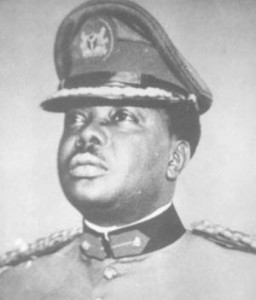
It may not be an extravagant exaggeration to paint General Murtala Muhammed as a hurricane. His brief rule as a military head of state in the 1970s had the intensity of a hurricane. So intense was his touch, and so consequential, that the effects and after-effects endure as the country remembers his assassination 40 years ago on February 13, 1976.
Muhammed was 37 when he died after being shot by coupists who took advantage of his fatalism. He was under-protected on the road when his killers struck. The black Mercedes Benz saloon car in which he was shot on his way to work in Lagos lies in a museum with all the blood stains of the bloodshed. Muhammed’s Aide-De-Camp (ADC), Lieutenant Akintunde Akinsehinwa, was in the car with him and was also killed. The historically significant car is a grim signification of times when the gun was the governor.
It is a striking irony that a military ruler could have been so carefree concerning his personal security that only a pistol carried by his orderly, who was also in the car, suggested protection concerns. It is curious that Muhammed apparently underestimated his vulnerability, despite his leadership style that attracted hostility from enemies of his messianic zeal and the change he symbolised.
The failure of the coup attempt led by Lt. Col Buka Suka Dimka, and Muhammed’s succession by the then Chief of Staff, Supreme HQ, Olusegun Obasanjo, trigger reflections on what might have been and what might not have been.
What if the coup attempt had succeeded? What if someone else, not Obasanjo, had succeeded Muhammed? What if Obasanjo did not have greatness thrust upon him at that critical juncture? It may be said that the country’s political trajectory since Muhammed’s assassination cannot be divorced from his assassination.
After the hurricane, there is The Hurricane, a new book on Muhammad by Taiwo Ogundipe, which will be presented on February 20 at the Coronation Hall, Government House, Kano. The book launch is part of activities organised by the Kano State government to mark the 40th anniversary of Muhammed’s assassination.
The author said in a statement: ”To date, most of the books that have been written by some of the major participant-observers on the military’s involvement in Nigeria’s governance have only made passing references to Murtala. A number of books, which have been specifically written on his tenure, focus largely on his administrative policies and pronouncements. None so far has given a detailed human-angle account of his life and death.”
Ogundipe described his book as “a product of extensive research and interviews.” He added: “This book traces the roots of the General and his progenitors. It also focuses on his birth, his growing up years, his schooling days, his life as a young man, his military training and career. The book also highlights his marriage and family life, his performance as a soldier, his involvement in the post-independence crisis that engulfed the nation, his emergence as a national leader, his role as head of state, his tragic death and finally the after-effects.”
According to the publisher, Topseal Communications, “The Hurricane, after a thorough assessment, secured the official approval of the Nigerian Educational Research and Development Council of the Federal Ministry of Education, Abuja, and has been certified suitable for use in Nigerian educational institutions and recommended for the general public.”
It is a testimony to the weight of Ogundipe’s book that no less a person than ex-President Olusegun Obasanjo wrote the foreword. This is the same man that succeeded Muhammed and realised his plan for civilian rule by handing power over to Shehu Shagari on October 1, 1979. This is the same man that sensationally returned to power as an elected president in 1999 and completed two terms.
Obasanjo said: “General Muhammed may have been in power for only six months, before he was tragically assassinated, but those are six months that are indelibly embossed on records of modern Nigeria. For they were six months when Nigeria intensely experienced leadership that was focused, dedicated, dynamic and selfless. Most importantly, those six months provided the launching pad for the most positive developments in leadership orientation in this country, including the handover of power to the elected government in 1979.”
Obasanjo continued: “The Hurricane has effectively captured the historical perspectives of the work of the General, depicting his effort to bring about discipline and sanitisation of the military and the Nigerian civil society. Given the present moral condition in Nigeria, where corruption is so pervasive, this book is a refreshing opportunity for reflections on the past…and the man who has since come to symbolise the crusade for the good of our country.”
The crusade continues. After the hurricane, there is The Hurricane.
NATION
END

Be the first to comment